Weeder's Digest: Hairy Bittercress
As fall arrives, you may start noticing a pesky little weed popping up in your lawn or garden: Hairy Bittercress. While it may not be as well-known...
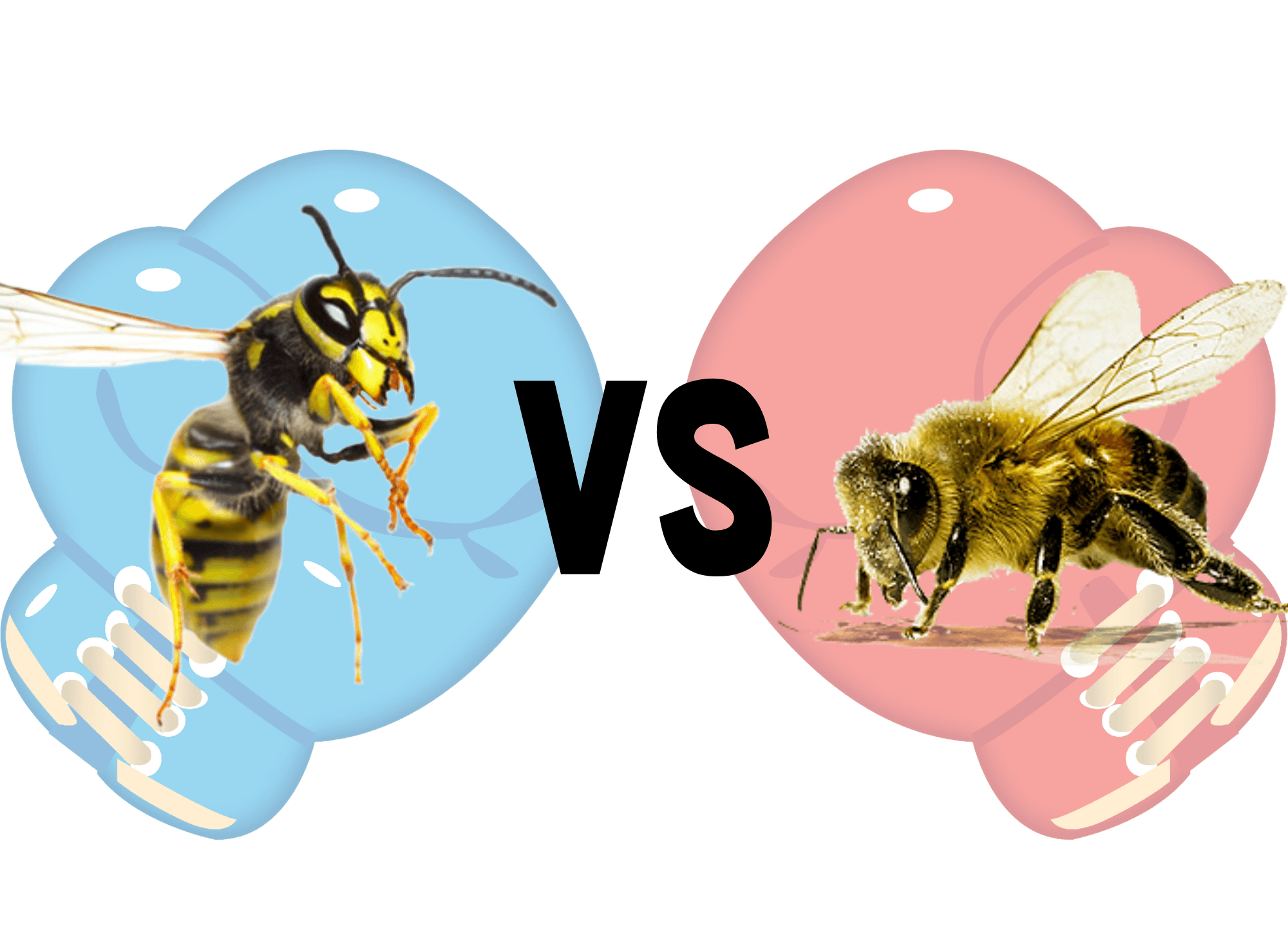
In the realm of insects, the allure of yellow stripes often serves as a visual warning, signaling both beauty and potential peril. Among these strikingly adorned creatures are those equipped with a potent defense mechanism: the ability to deliver a painful sting. From the iconic yellow jacket to the diminutive but formidable honeybee, and the lesser-known yet equally formidable hoverfly, yellow-striped insects wielding stingers command attention and respect. In this guide, we embark on a journey into the realm of these buzzing sentinels, exploring their characteristics, behaviors, and the vital roles they play in ecosystems, while also offering insights into safety and coexistence for those who share their habitats.
Carpenter Bee
Carpenter bees 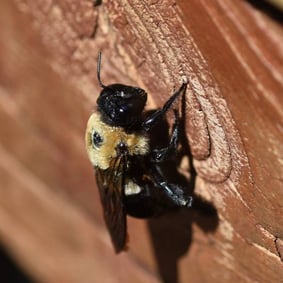 are remarkable insects renowned for their robust size and distinctive behaviors. Typically recognized by their stout bodies adorned with smooth, shiny black or metallic blue hues, carpenter bees often exhibit a striking yellow or white patch of hair on their thorax. Unlike many other bee species, carpenter bees are solitary creatures, each female creating her own nest in wood by burrowing into soft, unpainted surfaces such as dead tree trunks, wooden beams, or even structural timbers of buildings. While male carpenter bees are often territorial and may buzz threateningly near humans, they lack a stinger and thus cannot inflict a painful sting. However, female carpenter bees, equipped with a potent stinger, may sting if provoked, though they are generally docile unless directly handled or threatened. Despite their intimidating appearance, these bees primarily focus on foraging for nectar and pollen, making them valuable pollinators in many ecosystems.
are remarkable insects renowned for their robust size and distinctive behaviors. Typically recognized by their stout bodies adorned with smooth, shiny black or metallic blue hues, carpenter bees often exhibit a striking yellow or white patch of hair on their thorax. Unlike many other bee species, carpenter bees are solitary creatures, each female creating her own nest in wood by burrowing into soft, unpainted surfaces such as dead tree trunks, wooden beams, or even structural timbers of buildings. While male carpenter bees are often territorial and may buzz threateningly near humans, they lack a stinger and thus cannot inflict a painful sting. However, female carpenter bees, equipped with a potent stinger, may sting if provoked, though they are generally docile unless directly handled or threatened. Despite their intimidating appearance, these bees primarily focus on foraging for nectar and pollen, making them valuable pollinators in many ecosystems.
Honeybee
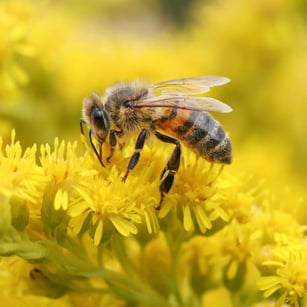 Honeybees are perhaps the most well-known and economically significant species of bee. Recognized for their industrious nature and intricate social structures, honeybees play a vital role in pollination and honey production. These bees have slender bodies adorned with alternating bands of yellow and black, and they exhibit a highly organized social hierarchy within their colonies, which consist of a single queen, thousands of female worker bees, and a smaller number of male drones. Honeybees possess barbed stingers that are designed to lodge in the flesh of their adversaries, causing the bee to die after stinging. However, honeybees are not inherently aggressive and typically only sting in defense of their hive or when they perceive a threat to themselves or their colony. Despite their defensive capabilities, honeybees are invaluable to ecosystems and agriculture, facilitating the pollination of countless plant species and providing humans with honey, beeswax, and other hive products.
Honeybees are perhaps the most well-known and economically significant species of bee. Recognized for their industrious nature and intricate social structures, honeybees play a vital role in pollination and honey production. These bees have slender bodies adorned with alternating bands of yellow and black, and they exhibit a highly organized social hierarchy within their colonies, which consist of a single queen, thousands of female worker bees, and a smaller number of male drones. Honeybees possess barbed stingers that are designed to lodge in the flesh of their adversaries, causing the bee to die after stinging. However, honeybees are not inherently aggressive and typically only sting in defense of their hive or when they perceive a threat to themselves or their colony. Despite their defensive capabilities, honeybees are invaluable to ecosystems and agriculture, facilitating the pollination of countless plant species and providing humans with honey, beeswax, and other hive products.
Bumblebee
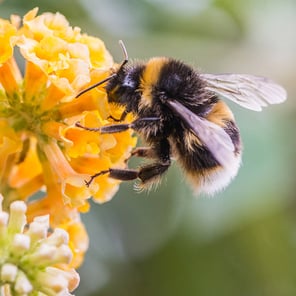 Bumblebees are beloved for their fluffy appearance and gentle demeanor. These robust insects are larger than many other bee species, with a round, furry body that is often adorned with vibrant yellow and black stripes, though some species may have orange or red markings. Bumblebees are social creatures, forming colonies typically consisting of a queen, worker bees, and male drones. They are important pollinators, efficiently collecting pollen with their specialized leg structures and transferring it between flowers as they forage for nectar. Unlike honeybees, which have barbed stingers that detach after a sting, bumblebees possess smooth stingers that allow them to sting repeatedly. However, bumblebees are generally not aggressive and will only sting when they feel threatened or cornered, such as if their nest is disturbed or if they are directly handled. Despite their ability to sting, bumblebees are valuable contributors to ecosystems and agriculture, playing a crucial role in pollination and the reproduction of flowering plants.
Bumblebees are beloved for their fluffy appearance and gentle demeanor. These robust insects are larger than many other bee species, with a round, furry body that is often adorned with vibrant yellow and black stripes, though some species may have orange or red markings. Bumblebees are social creatures, forming colonies typically consisting of a queen, worker bees, and male drones. They are important pollinators, efficiently collecting pollen with their specialized leg structures and transferring it between flowers as they forage for nectar. Unlike honeybees, which have barbed stingers that detach after a sting, bumblebees possess smooth stingers that allow them to sting repeatedly. However, bumblebees are generally not aggressive and will only sting when they feel threatened or cornered, such as if their nest is disturbed or if they are directly handled. Despite their ability to sting, bumblebees are valuable contributors to ecosystems and agriculture, playing a crucial role in pollination and the reproduction of flowering plants.
Hoverfly
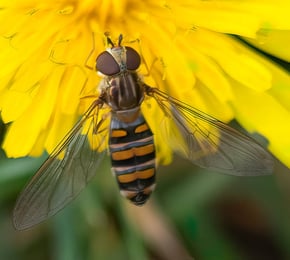 Hoverflies are fascinating insects that mimic the appearance of bees and wasps, often sporting vibrant yellow and black markings on their bodies to deter predators. Unlike bees and wasps, hoverflies do not possess stingers and are entirely harmless to humans. Their distinctive flying pattern, characterized by hovering in mid-air before darting off with remarkable agility, gives them their common name. Hoverflies are important pollinators, visiting a wide range of flowering plants in search of nectar and pollen. In addition to their role as pollinators, hoverfly larvae play a crucial ecological role as well, as many species are voracious predators of aphids and other garden pests, making them valuable allies in natural pest control. With their harmless nature, striking appearance, and beneficial ecological contributions, hoverflies are celebrated members of the insect world, embodying the delicate balance of beauty and utility in nature.
Hoverflies are fascinating insects that mimic the appearance of bees and wasps, often sporting vibrant yellow and black markings on their bodies to deter predators. Unlike bees and wasps, hoverflies do not possess stingers and are entirely harmless to humans. Their distinctive flying pattern, characterized by hovering in mid-air before darting off with remarkable agility, gives them their common name. Hoverflies are important pollinators, visiting a wide range of flowering plants in search of nectar and pollen. In addition to their role as pollinators, hoverfly larvae play a crucial ecological role as well, as many species are voracious predators of aphids and other garden pests, making them valuable allies in natural pest control. With their harmless nature, striking appearance, and beneficial ecological contributions, hoverflies are celebrated members of the insect world, embodying the delicate balance of beauty and utility in nature.
Paper Wasp
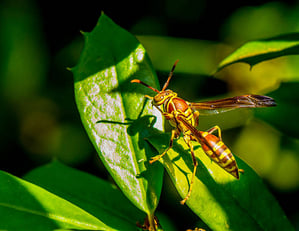 Paper wasps are notable for their slender bodies and distinctively elongated abdomens, often displaying a combination of black, brown, and yellow markings. These social insects construct their papery nests by chewing up wood fibers and mixing them with saliva, creating intricate hexagonal cells in which they rear their young. Unlike honeybees, which have barbed stingers that detach after a single sting, paper wasps possess smooth stingers, allowing them to deliver multiple stings if provoked. Paper wasps are generally not aggressive but will defend their nests vigorously if threatened, posing a potential hazard to humans who inadvertently disturb their colonies. However, they typically only sting in self-defense and will not attack unless provoked. Despite their defensive capabilities, paper wasps are beneficial predators, feeding on a variety of garden pests such as caterpillars and flies, making them valuable contributors to ecosystem balance.
Paper wasps are notable for their slender bodies and distinctively elongated abdomens, often displaying a combination of black, brown, and yellow markings. These social insects construct their papery nests by chewing up wood fibers and mixing them with saliva, creating intricate hexagonal cells in which they rear their young. Unlike honeybees, which have barbed stingers that detach after a single sting, paper wasps possess smooth stingers, allowing them to deliver multiple stings if provoked. Paper wasps are generally not aggressive but will defend their nests vigorously if threatened, posing a potential hazard to humans who inadvertently disturb their colonies. However, they typically only sting in self-defense and will not attack unless provoked. Despite their defensive capabilities, paper wasps are beneficial predators, feeding on a variety of garden pests such as caterpillars and flies, making them valuable contributors to ecosystem balance.
Yellow Jacket
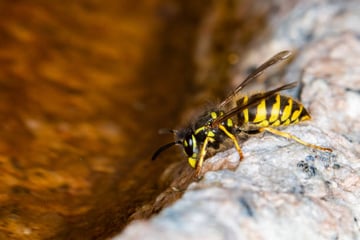 Yellow jackets are among the most recognizable and notorious members of the wasp family. These insects are characterized by their distinctive yellow and black striped abdomens and slender bodies, typically measuring around half an inch to one inch in length. Yellow jackets are social insects, forming colonies that can consist of thousands of individuals, including workers, queens, and males. They construct large papery nests, often underground or in aerial locations, where they rear their brood and defend their territory. Unlike honeybees, yellow jackets possess smooth stingers, enabling them to sting repeatedly if provoked. They are known for their aggressive defense of their nests, and their stings can be painful and potentially dangerous, especially for those allergic to their venom. While yellow jackets primarily feed on insects, they are also attracted to sugary substances, making them frequent visitors to picnics and outdoor gatherings. Despite their reputation as pests, yellow jackets play a valuable ecological role as predators, helping to control populations of other insects.
Yellow jackets are among the most recognizable and notorious members of the wasp family. These insects are characterized by their distinctive yellow and black striped abdomens and slender bodies, typically measuring around half an inch to one inch in length. Yellow jackets are social insects, forming colonies that can consist of thousands of individuals, including workers, queens, and males. They construct large papery nests, often underground or in aerial locations, where they rear their brood and defend their territory. Unlike honeybees, yellow jackets possess smooth stingers, enabling them to sting repeatedly if provoked. They are known for their aggressive defense of their nests, and their stings can be painful and potentially dangerous, especially for those allergic to their venom. While yellow jackets primarily feed on insects, they are also attracted to sugary substances, making them frequent visitors to picnics and outdoor gatherings. Despite their reputation as pests, yellow jackets play a valuable ecological role as predators, helping to control populations of other insects.
Cicada Killer
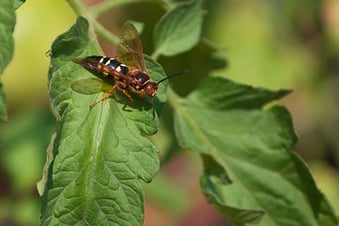 Cicada killers are large and intimidating insects. These solitary wasps are named for their unique behavior of hunting cicadas, which they paralyze with venom before carrying them back to their underground burrows as food for their larvae. Cicada killers are among the largest wasp species in North America, with females reaching lengths of up to two inches, while males are slightly smaller. They are characterized by their robust bodies, often marked with yellow or orange stripes on a black background and their powerful, buzzing flight as they patrol their territory in search of prey. Despite their formidable appearance and fearsome hunting habits, cicada killers are generally docile towards humans and rarely sting unless directly handled or threatened. While their sting can be painful, these wasps are not aggressive and will typically only defend themselves if provoked, making them fascinating yet harmless inhabitants of their ecosystems.
Cicada killers are large and intimidating insects. These solitary wasps are named for their unique behavior of hunting cicadas, which they paralyze with venom before carrying them back to their underground burrows as food for their larvae. Cicada killers are among the largest wasp species in North America, with females reaching lengths of up to two inches, while males are slightly smaller. They are characterized by their robust bodies, often marked with yellow or orange stripes on a black background and their powerful, buzzing flight as they patrol their territory in search of prey. Despite their formidable appearance and fearsome hunting habits, cicada killers are generally docile towards humans and rarely sting unless directly handled or threatened. While their sting can be painful, these wasps are not aggressive and will typically only defend themselves if provoked, making them fascinating yet harmless inhabitants of their ecosystems.
Dirt Dauber
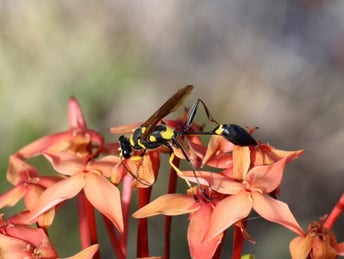 Dirt daubers are solitary wasps. These slender insects are distinguished by their elongated bodies, narrow waists, and distinctive habit of building nests from mud. They construct their nests in sheltered locations such as under eaves, in attics, or inside abandoned structures. Unlike social wasps, dirt daubers do not live in colonies and are not aggressive towards humans. Instead, they focus on hunting spiders, which they paralyze with venom and store in their mud nests as food for their larvae. While dirt daubers are capable of stinging, they are generally non-aggressive and only sting when directly threatened or handled. Their sting is typically mild and poses little threat to humans, making these industrious insects beneficial predators of spiders rather than pests to be feared.
Dirt daubers are solitary wasps. These slender insects are distinguished by their elongated bodies, narrow waists, and distinctive habit of building nests from mud. They construct their nests in sheltered locations such as under eaves, in attics, or inside abandoned structures. Unlike social wasps, dirt daubers do not live in colonies and are not aggressive towards humans. Instead, they focus on hunting spiders, which they paralyze with venom and store in their mud nests as food for their larvae. While dirt daubers are capable of stinging, they are generally non-aggressive and only sting when directly threatened or handled. Their sting is typically mild and poses little threat to humans, making these industrious insects beneficial predators of spiders rather than pests to be feared.
In conclusion, the world of yellow-striped insects encompasses a diverse array of species, each with its unique characteristics and behaviors. While some, like the honeybee and bumblebee, play crucial roles as pollinators and providers of honey, others, such as the yellow jacket and paper wasp, command caution with their potent stings. Understanding the behaviors and habits of these insects is key to fostering safe and harmonious interactions with them in our environments. By appreciating the ecological contributions of these creatures while also respecting their potential to defend themselves, we can coexist with these remarkable insects and contribute to the preservation of biodiversity. Whether admiring the delicate beauty of a hoverfly or marveling at the industriousness of a carpenter bee, let us continue to explore and appreciate the intricate world of yellow-striped insects, embracing both their splendor and their sting.
If you're encountering challenges with other pests like fire ants, termites, and mosquitoes, be sure to explore our range of pest control programs!
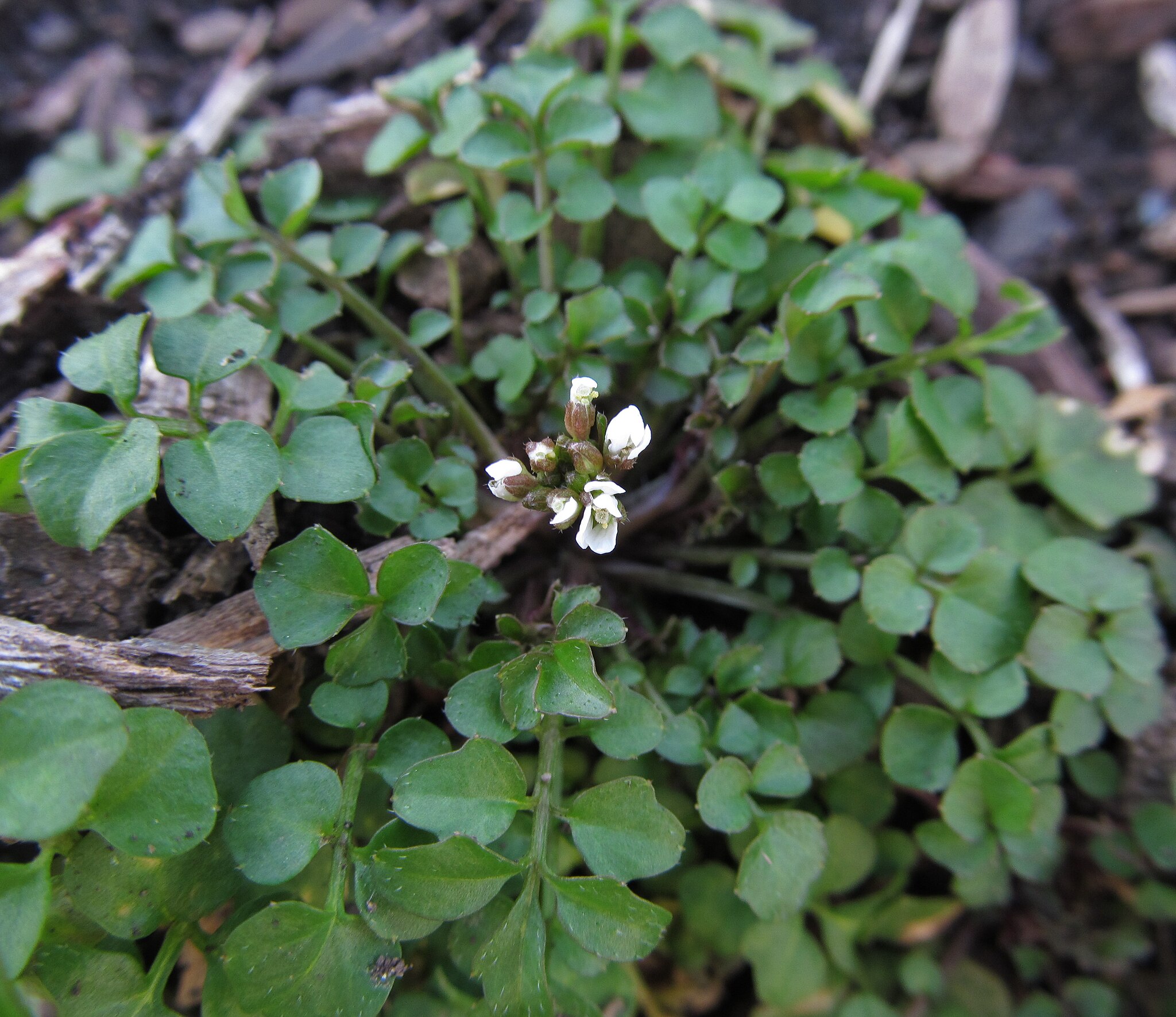
As fall arrives, you may start noticing a pesky little weed popping up in your lawn or garden: Hairy Bittercress. While it may not be as well-known...
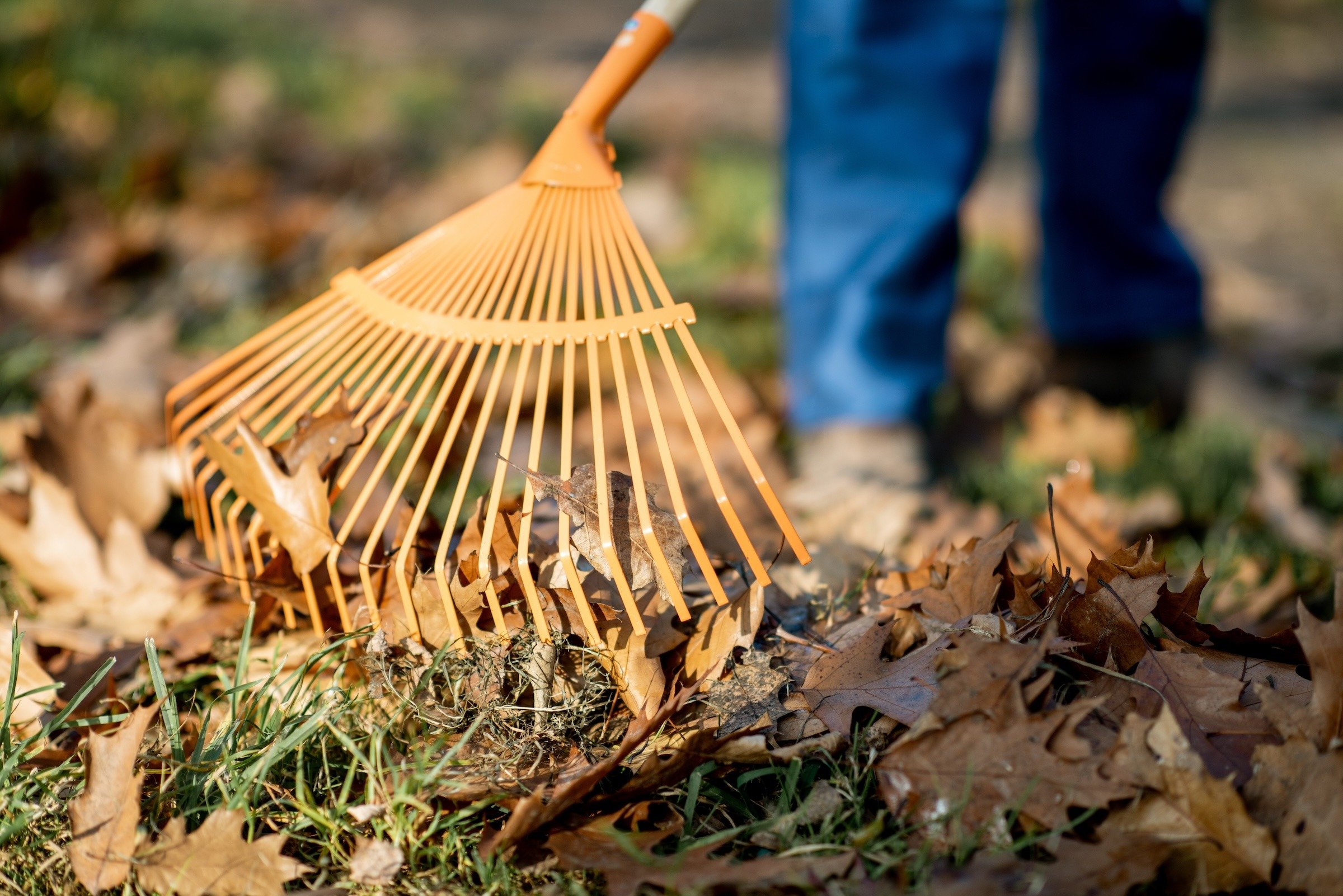
As autumn approaches, the vibrant hues of falling leaves can create a picturesque landscape. However, while the sight may be beautiful, the...

As the seasons transition and spring approaches, it's time to prepare your lawn for a season of growth and vitality. Among the many tasks on your...